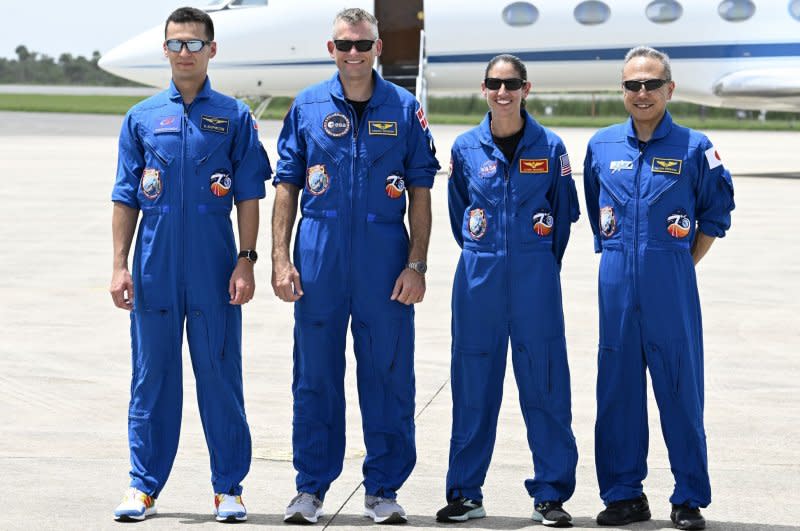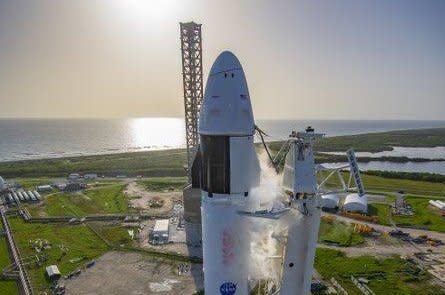NASA's Crew 7 mission to space station on schedule for Friday' launch

- Oops!Something went wrong.Please try again later.
- Oops!Something went wrong.Please try again later.
Aug. 23 (UPI) -- NASA's Crew 7 mission is on track and counting down toward a launch scheduled for early Friday of a SpaceX crew rotation flight to the International Space Station orbiting 250 miles above Earth, the space agency said.
SpaceX successfully completed a static test fire Tuesday of the Falcon 9 rocket, clearing the way for Friday's launch from Kennedy Space Center in Florida at 3:49 a.m. EDT.
The mission is to send the Crew Dragon Endurance capsule into orbit with four astronauts aboard. Docking with the space station is planned early Saturday.
The weather also looks good for an on-time launch, with the latest forecast from the unit of the U.S. military that provides detailed forecasts for air and space operations in the United States predicting a low probability of rain or storms delaying liftoff from Launch Complex 39A.
However, Space Force 45th Weather Squadron's primary concern is from low-level cumulus clouds starting at around 2,500 feet all the way up to 12,500 feet, but it calculates only a 15% risk the so-called "Cumulus Cloud Rule" will impact an on-time departure.

Following liftoff, the reusable stage 1 booster of the Falcon rocket will be jettisoned after about 9 minutes and descend to land on SpaceX's autonomous drone ship, followed minutes later by separation from the second-stage booster as Dragon Endurance enters into orbit.
Dragon is scheduled to dock with the space station about 32 hours later at 2:02 a.m. Saturday, with the hatch opening some 2 1/2 hours after that at 3:47 a.m.

The crew, American Jasmin Moghbeli of NASA, Andreas Mogensen of the European Space Agency, Satoshi Furukawa of Japan Aerospace Exploration Agency and Konstantin Borisov of Russia's Roscosmos space agency, will spend six months aboard the space station, carrying out a range of scientific experiments, technology demonstrations, research and maintenance tasks.
German-born Moghbeli, 40, hails from Baldwin, N.Y., to which she emigrated with her Iranian-born parents in the 1980s. She will serve as mission commander.

Moghbeli is a Marine Corps test pilot, who has flown more than 150 combat missions, has a master's degree ai aerospace engineering from the Naval Postgraduate School and is a distinguished graduate of the U.S. Naval Test Pilot School in Maryland.
Mission specialist Mogenson, from Denmark, has a doctorate in aerospace engineering from the University of Texas at Austin, with research interests focused on guidance, navigation and spacecraft control during entry, descent and landing. He also specializes in mission analysis and design and trajectory optimization.

Furukawa, 59, born in Yokohama, Japan, is a former physician with a doctorate in medicine from Yokohama, Japan, who spent 165 days aboard the space station from June to November 2011 supporting the final Space Shuttle mission, STS-135.
He qualified as a NASA mission specialist in 2006 and headed up JAXA's Space Biomedical Research Group from 2014 to 2021. He also has flown on Russian Soyuz missions.
Borisov, 39, who will serve as the mission's flight engineer, was born in Smolensk, Russia, and has a master of science degree in program life support systems for aircraft, with the qualification master of aircraft building from Moscow Aviation Institute.
He was selected as a cosmonaut in the 2018 intake with seven other candidates and qualified for spaceflight assignments in 2020.
Aboard the space station, they will join the astronauts of Crew 6, NASA's Stephen Bowen and Warren Hoburg, the United Arab Emirates' Sultan Alneyadi and Roscosmos' Andrey Fedyaev -- set to return to Earth aboard Dragon Endurance on Sept. 1 -- plus Sergey Prokopyev, Dmitry Petelin and Francisco Rubio from Roscosmos' MS-22 mission, who are in their 10th month on the space station.
The four Crew 7 astronauts arrived at KSC on Sunday ready to begin pre-launch activities the next day, including a flight readiness review and a Dragon test-firing.
The Dragon Endurance capsule, named for the SpaceX and NASA teams who built the spacecraft and trained the astronauts who fly it, also is a nod to explorer Sir Ernest Shackleton's ship used in his 1914 Imperial Trans-Antarctic Expedition.

